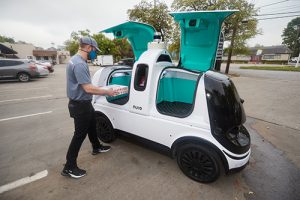As artificial intelligence (AI) rapidly seeps into the restaurant industry, pizza giant Domino’s is one of the latest to test out new operational technologies.
Via an ongoing partnership with Microsoft, Domino’s will utilize Microsoft Cloud and Azure OpenAI to modernize the pizza hub’s store systems to simplify customer and employee service.

Kelly Garcia, Domino’s Chief Technology Officer
A bulk of the co-investment lies in back-of-house technology with the development of a generative AI assistant, to allow store managers to ask questions and quickly make decisions on labor scheduling, inventory management, ingredient ordering and more.
“Our stores have become increasingly complex with the order volumes that we do, with all the technology involved and rising cost of food and labor, we really have to help these store team members better manage operations,” said Kelly Garcia Domino’s chief technology officer. “And every small decision that can save a minute or two minutes…think about that across 20,000 stores around the world that’s a lot.”
Working with AI is nothing new for the global pizza hub. For years, the company has already leveraged machine learning models to predict labor needs, provide sales forecasts and demand. However, with the recent onset of the latest version of artificial intelligence, generative AI, which utilizes natural language processing, data coming in for Domino’s employees can now be further simplified.
“What’s interesting is, it has only been about a year now since generative AI has come onto the scene, which really reduces consumer friction through the use of technology,” said Garcia.
Thinking about day parts and evening rushes, Garcia says “with all the signals coming in, they [store managers] shouldn’t have to get away from the job to go back to the office to look at a report, they should be able to ask that question to inform them and then hopefully take action on that really quickly.”
With the ongoing advancement of voice AI and language processing, Garcia adds that Domino’s felt it was the right time to implement the technologies as “the tech has caught up to match the way humans naturally want to interface.”
“It feels like—and it’s not just Domino’s—that we are finally at that point where we can start making meaningful progress to change the way consumers are going to interface with computers, in a drastic way,” Garcia said.
Along with deploying the chat AI assistant, Domino’s will also relaunch its website, using AI to enhance the ordering experience for customers through further personalization as well as enabling strategies to streamline pizza prep and quality controls.
In addition, Domino’s and Microsoft will establish an Innovation Lab, pairing both companies’ leaders with engineers to accelerate the time to market for smart store and ordering innovations.
“As consumer preferences rapidly evolve, generative AI has emerged as a game changer for meeting new demands and transforming the customer experience. Through our strategic partnership, Domino’s continues to be a customer-first leader in the quick service restaurant industry,” Shelley Bransten, Microsoft corporate vice president of global retail, consumer goods and gaming industries, said in a statement.
Exact details of the five-year partnership will continue to be announced with the piloting of generative AI solutions hitting stores within the next six months.
Tasting the future of innovation
On the delivery side of things, Domino’s has continued to evaluate new forms of autonomous technology, with past launches of self-driving delivery bots and tests of drone delivery.

Domino’s launched autonomous delivery with Nuro’s R2 robot out of a Houston, TX store in 2021.
When asked about future plans to scale like-technologies, Garcia says sidewalk autonomous units are probably the nearest, while scaling self-driving vehicles that drive up to 25 mph on the road remains a longer-term outlook.
Meanwhile, delivering with flying drones at scale is seemingly further down the list for Domino’s due to complexities in heat and staging in the retail environment.
“We are still very bullish, like we did for generative AI, we are waiting for the technology to catch up to the plans that we have,” said Garcia.


